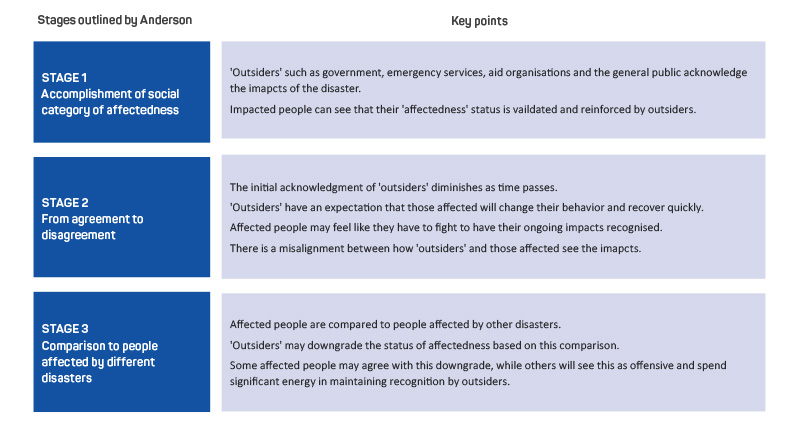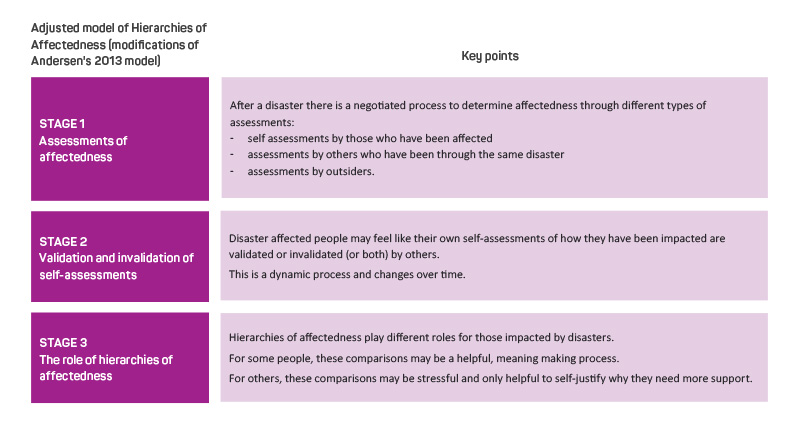It's well established that disasters result in a wide range of consequences that are felt unevenly by those affected. This research looked at what people who had experienced disasters in Australia and New Zealand found helpful and unhelpful in their recovery.
This article draws on a longer paper published by Brady, Gibbs and Harms (2021).1 In that study, participants mentioned comparing their experiences to others who had been affected by the same disaster to figure out where they should be in their recovery. Participants also indicated they felt judgement about how badly they had been affected compared to others. The findings from this study were used to adapt an existing model of hierarchies of affectedness. It is important to understand how hierarchies of affectedness are formed, how they can be used and how negative consequences can be reduced because of how they affect people and communities.
A hierarchy of affectedness emerges when the level or type of disaster experienced by an individual, family or community is compared to others in the same or different events (Andersen 20132). Examples of where these formal hierarchies develop include the creation of eligibility criteria for accessing financial assistance (such as grants) and other forms of aid after events. Hierarchies of affectedness are not commonly referred to in emergency and disaster policy and doctrine. Nonetheless, both explicit and implicit hierarchies are formed after such events to determine who are the most and least affected.
One of the ways that governments, not-for-profit organisations, the media and the public determine the proportionality of their response to extreme events is by comparing it to previous events. These comparisons form a ranking. ‘Is this event worse than the last one, or is it not as bad?’ This leads to other decisions about how much funding should be allocated, should people donate, should services be expanded, should news crews be sent to cover the event, should an appeal be established.
These comparisons and subsequent hierarchies have practical implications for people affected. In the immediate aftermath of an extreme event, it is common to use language like ‘those worst affected’, ‘those hardest hit’ and ‘unprecedented damage’ as a way to explain how resources are allocated. Even though the concept of ‘hierarchies of affectedness’ is not widely discussed in emergency management and its research, these social comparisons are used in other areas of social research, such as explorations of hierarchies of grief and hierarchies of harm from war. There is a lot to learn from these fields:
- To have a hierarchy, some effects need to be elevated in importance and others need to be diminished: some people’s experiences will be recognised more than others.
- Hierarchies are used to determine eligibility for resources such as financial assistance and compensation: by making some people eligible, others will be considered ineligible.
- Hierarchies formed by ‘outsiders’ such as government are rarely nuanced enough to reflect the complexities experienced by affected communities: ‘outsiders’ rank impacts to determine where to allocate resources but such assessments do not tell the whole story.
- Hierarchies create categories that can create or exacerbate divisions that can be detrimental to community recovery.
In 2013, Blom Andersen2 developed a model of hierarchies of affectedness after disasters following research into the aftermath of an explosion in a fireworks factory in Kolding. The model developed (Figure 1) follows a number of steps.

Figure 1: Andersen's (2013) model of hierarchies of effectiveness.
Our research looked at the experiences of people affected by disasters in Australia and New Zealand.1 From on our findings, we identified 4 gaps in Andersen’s model that we adapted our model to include (Figure 2). These were:
- Disaster affected people used comparisons to others impacted by the same event as part of their self-assessments.
- The types of assessments that ‘insiders’ and ‘outsiders’ undertake are different in both their content but also their pace. The self-assessments that disaster affected people undertook tended to be more holistic and dynamic and included intangible impacts and secondary stressors, while outsiders tended to focus on the tangible impacts.
- Disaster affected people could experience both validation and invalidation of their experiences simultaneously.
- Disaster affected people used the role of these hierarchies differently. For some people, they were a helpful sense-making tool at a time where other social comparison markers were no longer available. However, for others these comparisons were a source of anger and injustice.
Figure 2: Adjusted model of hierarchies of affectedness (Brady, Gibbs & Harms 20211).
That research also showed that participants used hierarchies of affectedness to orientate themselves at a time of dramatic upheaval. For some participants, comparing themselves to others was helpful. They used their observations in a constructive way to reframe their experience. Conversely, for participants who felt like their experience had been diminished by others, hierarchies of affectedness served to demonstrate how bad their experiences had been. They used the comparisons to others affected by the same event to self-justifying why they needed more support.
Understanding hierarchies of affectedness
Understanding hierarchies of affectedness is important because they have practical implications for people and their recovery. Hierarchies of affectedness can help us understand how resource allocation after a disaster can be influenced. They can also help us understand the perceptions some disaster affected people have about the help they have received. It can be common for individuals and communities to feel they have been forgotten and their experiences are unacknowledged by governments, agencies and the public. When people feel like they have been badly affected but their concerns have gone unnoticed, or worse, have been diminished, it’s natural for divisions to arise, frustration to grow and a sense of injustice to follow. These divisions can reduce the benefits that community connections after events can have. Experiencing and recovering from disasters is usually a stressful process and secondary stressors can make the experience harder.
Outsiders (such as governments, not-for-profit organisations and media organisations) need to understand that the processes they use to assess and determine levels of affectedness may:
- not be comprehensive
- diminish the experiences of people affected
- cause divisions within affected communities.
This is not to say that hierarchies won’t need to be used to help make assessments about the types of support available, who is eligible and how resources are prioritised. But if organisations understand the role that decisions play in recovery, they can take steps to reduce their potential harm. Broad approaches to defining who is affected, community-led approaches to recovery, dynamic needs assessments and flexible support are ways that the potentially negative outcomes of hierarchies can be reduced and the potentially positive role of hierarchies can be amplified.
Endnotes
1. Brady K, Gibbs L & Harms L 2021, Hierarchies of affectedness after disasters. Health & Place, vol. 72, 102687.
2. Andersen NB 2013, Negotiations of acknowledgement among middle class residents: An analysis of post disaster interactions and performance in a Danish context. International Journal of Mass Emergencies and Disasters, vol. 31, no 2, pp.270–292.



